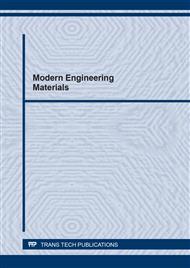[1]
S. B. Aziz, T. J. Woo, M. F. Z. Kadir, H. M. Ahmed, J. Sci.: Adv. Mater. Devices 3 (2018) 1-17.
Google Scholar
[2]
K. S. Ngai, S. Ramesh, K. Ramesh, J. C. Juan, Ionics 22 (2016) 1259-1279.
DOI: 10.1007/s11581-016-1756-4
Google Scholar
[3]
P. Yao, H. Yu, Z. Ding, Y. Liu, J. Lu, M. Lavorgna, J. Wu, X. Liu, Front. Chem. 7 (2019) 522.
Google Scholar
[4]
V. At Nguyen, C. Kuss, J. Electrochem. Soc. 167 (2020) 065501.
Google Scholar
[5]
E. Kartini, C. T. Genardy, IOP Conf. Ser.: Mater. Sci. Eng. 924 (2020) 012038.
DOI: 10.1088/1757-899x/924/1/012038
Google Scholar
[6]
D. S. Sanditov, M. I. Ojovan, Physica B 523 (2017) 96-113.
Google Scholar
[7]
Q. Zheng, J. C. Mauro: J. Amer. Ceram. Soc. 100 (2017) 6-25.
Google Scholar
[8]
P. Koštál, J. Shánělová, J. Málek: Intern. Mater. Rev. 65 (2020) 63-101.
Google Scholar
[9]
J. C. Qiao, Q. Wang, J. M. Pelletier, H. Kato, R. Casalini, D. Crespo, E. Pineda, Y. Yao, Y. Yang, Prog. Mater. Sci. 104 (2019) 250-329.
DOI: 10.1016/j.pmatsci.2019.04.005
Google Scholar
[10]
M. Aniya, J. Therm. Anal. Cal. 69 (2002) 971-978.
Google Scholar
[11]
M. Ikeda, M. Aniya, J. Non-Cryst. Solids 371-372 (2013) 53-57.
Google Scholar
[12]
M. Aniya, M. Ikeda, Ionics 16 (2010) 7-11.
Google Scholar
[13]
M. Ikeda, M. Aniya, J. Phys. Soc. Jpn. 79 (2010) Suppl. A, 150-153.
Google Scholar
[14]
Sahara, M. Aniya, J. Solid State Electrochem. 16 (2012) 1883-1887.
Google Scholar
[15]
M. Aniya, M. Ikeda, Sahara, J. L. Ndeugueu, Arab. J. Sci. Eng. 39 (2014) 6627-6633.
Google Scholar
[16]
M. Ikeda, M. Aniya, Materials 3 (2010) 5246-5262.
Google Scholar
[17]
D. Fragiadakis, S. Dou, R. H. Colby, J. Runt, J. Chem. Phys. 130 (2009) 064907.
Google Scholar
[18]
R. Böhmer, K. L. Ngai, C. A. Angell, D. J. Plazek, J. Chem. Phys. 99 (1993) 4201-4209.
Google Scholar
[19]
C. M. Roland, Macromol. 27 (1994) 4242-4247.
Google Scholar
[20]
J. K. W. Glatz-Reichenbach, L. J. Sorriero, J. J. Fitzgerald, Macromol. 27 (1994) 1338-1343.
Google Scholar
[21]
J. Cruickshank, H. V. St. A. Hubbard, N. Boden, I. M. Ward, Polymer 36 (1995) 3779-3781.
Google Scholar
[22]
M Aniya, T. Shinkawa, Mater. Trans. 48 (2007) 1793-1796.
Google Scholar
[23]
M. Ikeda, M. Aniya, Intermet. 18 (2010) 1796-1799.
Google Scholar
[24]
M. Aniya, M. Ikeda, Phys. Procedia 48 (2013) 113-119.
Google Scholar
[25]
A. G. M. Ferreira, A. P. V. Egas, I. M. A. Fonseca, A. C. Costa, D. C. Abreu, L. Q. Lobo, J. Chem. Thermodyn. 113 (2017) 162-182.
Google Scholar
[26]
M. Aniya, M. Ikeda, Sahara, Mater. Sci. Forum 879 (2017) 151-156.
Google Scholar


